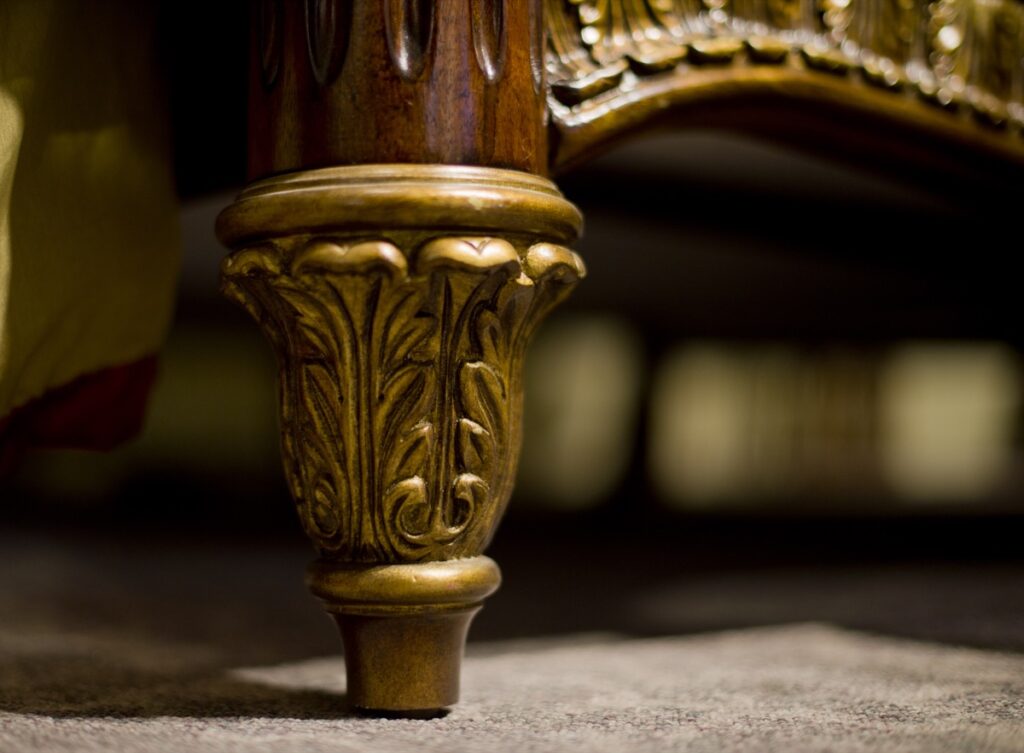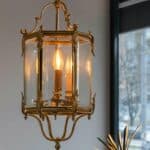Antique furniture has always been a popular home decorating trend. With the many different styles available, it’s easy to find an antique piece that fits your style and personality. But how do you know if the piece is authentic? The feet are one of the simplest ways to date an antique piece.
Multiple methods can help to date furniture by its feet. These methods include traditional, and all of them offer you a way to find the age of your table, chair, or other furniture items. One way is identifying the material, styles of nuts and bolts, damage polish/old brands, differentiation between original antiques.
Identifying antique furniture feet can help you research and value old items more accurately. From the Renaissance through the Empire periods, we've compiled a handy list of foot types commonly used across Europe and the United States, to assist in making a conclusion of the age of your antique furniture.
Antique Arrow Foot Furniture
This furniture foot style consists of a tapered cylinder that is separated from the leg by a turned ring. It is usually plain, even if the attached leg is fluted (as shown in this example). A shorter, more squat variation is sometimes referenced as a blunt-arrow foot.
Antique Ball Foot Furniture
The ball foot is a classic furniture foot design that dates back centuries. It's the most basic type of furniture foot style, with a simple spherical form and the occasional appearance on case pieces such as chests, secretaries, and sideboards.
It was popular in the late 1600s and throughout the 1700s, when it appeared in William and Mary-style furniture. The appeal of this foot design extended into the 1800s in American Federal pieces as well as "country" styles. The ball foot, onion foot, and turnip foot are all different forms of the ball foot.
Antique Ball and Claw Foot Furniture
A furniture foot, sometimes known as a bird's claw clutching a ball, depicts a bird's claw gripping a ball. They are commonly carved entirely of wood, as can be seen in many Chippendale-style pieces of furnishings.
Metal claws grasping a glass ball are yet another frequent motif, particularly on occasional tables and stools. Since it was created in the 1700s, this foot type has been extremely popular, with various versions existing almost continuously since then.
Antique Block Foot Furniture
The Block Foot style was popular in the mid-18th century English and American furniture. Although it was created centuries ago, it is still a favorite today. This foot type can be found on tables and chairs of all shapes and sizes. The block foot offers a simplistic, yet elegant appearance that blends well with any decorating theme. It has been seen on many pieces of antique furniture throughout history, making it one of the easiest ways to date an object by its feet. As you may have guessed from its name, this type of foot is traditionally square or cube-shaped with a flat top surface for stability as well as two small front legs for support when standing upright. A single wide leg can also provide support if necessary depending on how heavy the piece is.
Its name comes from the Greek word for "cube" which aptly describes its most basic shape, but there are several variations on the block foot including the ball-shaped version pictured here which sports a single leg and can be found protruding through many of George Hepplewhite's designs. It was one of the first furniture feet to appear in English neoclassical furniture, with William Kent using his own interpretation at around 1720. The block foot style also became popular in American pieces as well with Sheraton designing some circular examples that would later inspire Thomas Sheraton's son, Thomas junior, to continue this trend towards an oval version of the block foot with his own ogee-shaped design.
Antique Bracket Foot Furniture
This is one of the most basic chair foot designs, named for its genuine resemblance to a bracket. It has a mitered corner ornamentation and is usually mitered at the corners. It's also known as a console leg from time to time. The most basic form is the plain bracket foot has a smooth outside edge and a scalloped inside edge. Alternatives include the ogee bracket foot and the scroll bracket foot with a curved outer edge.
Antique Bun Foot Furniture
Bun feet are a type of furniture foot that is similar to the ball foot, but it has a bun shape on the underside. It was made popular in England during the Georgian period and early Victorian periods. Although there were other variations before it, this type of foot style became more common after Queen Anne's death in 1714. The word "bun" comes from 13th century Middle English meaning "to swell or bulge", which is what the foot style was meant to mimic.
Bun Feet are commonly used along with tripod feet because they are often larger in scale than ball feet but do not go all the way down to the floor as tripod legs do. This allows them to be higher off of the floor giving more space underneath for storage. They also work well if you have a chair or stool that is larger in scale and you want to make sure they do not appear too heavy. With a bun foot, the leg will give the appearance of being more slender.
Antique Cylindrical Foot Furniture Furniture
The cylindrical foot is a type of foot that is typically seen on Georgian and Neoclassical-style furniture from the latter half of the 18th century and early 19th century. This type of foot is found mainly on Sheraton design items. Despite their delicate appearance, they are still quite strong and robust. Some furniture might have them decorated with stringing or cast ornamentation, but this is not a deciding factor as some may have been cast on the foot by the manufacturer. Cylindrical feet are also seen on George III and Queen Anne pieces.
Antique Dolphin Foot Furniture
A fish head-shaped foot is an example of a carved furniture foot. The design may sometimes be carried throughout the leg or base of the item (as seen here). Dolphin arms and feet are sometimes included in pieces, such as chairs. The dolphin has been used as a decorative motif since Renaissance furniture, however it was particularly fashionable during the Regency period. It was especially popular in ornate Regency, Empire, and Biedermeier styles.
Antique French Foot Furniture
A slim variety of bracket feet (see above) that is typically tapered and has a convex form that extends outward. It's like a reduced version of a chair or table's saber leg. The French foot style is very popular with neoclassical designs because it offers an elegant appearance that does not take up too much space when placed next to another chair or stool. These pieces are also commonly made from mahogany wood with dark glossy finishings, making them stand out even more against their surroundings.
Antique Hoof Foot Furniture
The hoof foot, usually that of a deer, is an early form carved to resemble a realistic animal hoof. It was created at the same time as the cabriole leg with which it is associated, towards the end of the 17th century. It's also known as a pied-de-biche in French, which means "deer's foot.
Hoof feet are most common in Régence furniture, William and Mary chairs, early Louis XV, and Queen Anne furniture, and they lasted until the turn of the 19th cent
ury.
Antique Monopodium Foot Furniture
The monopodium foot is a type of furniture foot style with an ornate extension above, such as a scroll, wing, vine, or cornucopia, forming the lion's paw. It derives its name from ancient Greek, Roman, and Egyptian design influences. The monopodium (single-base) table was designed after ancient Greek, Roman, and Egyptian designs. The monopodium foot can also be seen on sofas, chairs, and case pieces.
Antique Ogee Bracket Foot Furniture
Ogee brackets are a distinctive feature of furniture from the late 18th and early 19th centuries. The foot, which comes to a point at one end, was often used for decorative purposes on elegant pieces such as secretaries or dressing tables.
Ogee brackets were also sometimes found on chairs or other types of furniture with four legs. The ogee bracket foot is still occasionally seen today in reproduction furniture but seldom if ever genuine antiques.
Ogee bracket feet may be attached to a flat, open foot with a molded edge or to an urn-shaped pedestal. Also, note the slight "S" curve in ogee bracket feet which makes them unique from other types of brackets.
In general, furniture from America between 1725 and 1800 will have either metal or wooden ogee bracket feet with no curves while English makers used both styles on their pieces but more frequently made of wood.
Antique Onion Foot Furniture
The onion foot is more than a century older than the escutcheon, dating from the Renaissance and gradually declining after the turn of the 18th century. Some usage of it in Dutch-influenced American furniture was observed throughout the 1700s.On heavy case pieces, especially of Germanic or Dutch origin, it is frequently encountered. Occasionally known as a melon foot.
Antique Pad Foot Furniture
The pad foot was first used in furniture in the early 18th century. It is especially common to Queen Anne style furniture. A disk or pad is placed under a simple, flattened oval-shaped block of wood to provide a distinctive foot. It is a form of clubfoot distinguished by the underlying disk. These are frequently found at the base of a cabriole leg. They are sometimes known as Dutch foot or spoon foot.
Antique Spade Foot Furniture
The spade foot is a rectangular form with a broad top that tapers down to a smaller bottom. It's not completely carved; rather, it's built by combining small pieces of wood to the base of a square, tapering leg.
Antique Toupie Foot Furniture
The rounded saucer-shaped top with a greater turning in the middle that then narrows to a smaller turned end is known as a turned foot. The overall appearance is similar to that of a spinning top (or 'toupie' in French). Occasionally referred to as a spool foot. Shorter and thicker examples are frequently used to decorate bulky item cases, while slenderer ones may be utilized on furniture. The toupie foot, which dates from the late 17th century, is often associated with the Louis XIV period.
Antique Trestle Foot Furniture
The T-shaped foot, one of the most ancient types—dating from the Middle Ages—in which a vertical pole is placed in the center of a horizontal section to form a T shape. Gustav Stickley's respect for plain, "honest" pieces drove him to create numerous tables with sturdy trestle feet.
The supporting beams or legs of a horizontal beam are usually flat and plain, but carved and elaborate versions do exist; they are typical of country-style or industrial furniture, such as dining tables or racks.
Antique Trifid Foot Furniture
The trifid form is a carved foot with three toes or lobes that resemble a stylized animal paw resting on a base—a cross between a paw foot and a clubbed pad foot. They are generally found at the end of a cabriole leg. This is sometimes known as an drake foot.
The fluted column is a stylistic trait of 18th-century design that shows up frequently in Queen Anne-style and early Chippendale pieces, particularly chairs and footstools. It was especially common in Irish and Philadelphia furniture, with regional variations. The sophisticated furniture produced in colonial Philadelphia, such as chairs with exaggerated dimensions, winged splats, shell motifs, and trifid feet, were all distinctive.
Antique Turnip Foot Furniture
A type of bun foot, this is a curved, turned furniture foot. It's bulb-shaped with a thin neck and bulges outward before taper down into a round collar or base. These may also be known as tulip feet. It was popular in William and Mary furniture from the late 17th century, and it reappeared in mid-19th century Revival decorative styles as well as more modest "country" pieces.
Antique Whorl Foot Furniture
A whorl foot, also known as a scroll foot and shaped like a spiral, curves up and in. It's sometimes referred to as a knurl toe. This design was originally designed in the late 17th century and is typically associated with Louis XV, Georgian, and other Rococo periods. It is frequently found on the final leg of a cabriole leg.
Antique furniture is a timeless way to add character to any room, but knowing which type of antique furniture you have can be difficult. Luckily for you, we’ve created this helpful guide that offers insight into the different types of feet and what they mean about your piece. If you want help dating your antiques by their feet, contact us today! We're experts in all things antique!






